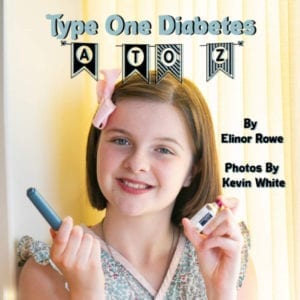
25 Aug Back to School Checklist(s)
When Ellie’s dad was a little boy, his mom sang “School Days” to him. I only know a few lines from Ellie’s own childhood when Jeff would sing it to her. As I pack diabetes supplies, I find myself humming and thinking about the refrain, “School days, school days, dear old golden rule days.” In these moments, “do unto others” feels less about reciprocity and more about how we love people each and every day. I pray that Ellie not only receives care and understanding when it comes to her diabetes but that she is the helpful kid, the innately kind person, and the one who looks for a fellow student in need of a friend. It’s my fervent hope that the golden rule flourishes in our classrooms as we usher in another school year

Stocking up on school supplies takes on new meaning for kids with T1D. Ellie has items in the nurse’s office for treating lows, trouble shooting her medical devices and infusion site, testing for ketones, and more. See the complete checklist.
The first assignment of the year for our family was to make a game plan for Ellie’s type one diabetes (T1D). Hello, homework! In a perfect world, teachers, school staff, and even classmates would understand how to manage diabetes so they could support Ellie. In the real world, we need to provide information to the school to keep Ellie safe, and we’ll gladly do it.
Our back-to-school approach includes:
Have a diabetes management plan in place.
Each year, we receive school orders from Ellie’s endocrinologist that are submitted to the school nurse and attached to her 504 plan (see below). We make sure Ellie’s diabetes plan is updated annually to reflect any treatment changes. It highlights:
- Target blood sugar range
- Low blood sugar (hypoglycemia) symptoms and how to treat low blood sugar
- Insulin, device supplies, and/or other necessary medications
- Bolus ratios and basal settings for the pump
- Meal and snack plans
- How to manage physical activities and sports
Low blood sugar can happen quickly and needs to be treated immediately! For Ellie, it’s most often caused by too much insulin, waiting too long for a meal or snack, or getting extra physical activity. Low blood sugar symptoms vary, so school staff should be familiar with specific symptoms as well as at what blood glucose (BG) reading your child’s continuous glucose monitor (CGM) will alert. Recognizing a low BG and having a protocol in place is a critical piece of Ellie’s diabetes management plan.
Review the 504 plan.
A 504 plan is a document used in schools to ensure that children with diabetes receive accommodations based on their unique health needs. Section 504 of the Rehabilitation Act of 1973 states that people with diabetes cannot be discriminated against because of their medical condition. In essence, this plan helps students, parents, and educators work as a team to make sure a child with diabetes has the same opportunities as fellow students.
Both the Juvenile Diabetes Research Foundation (JDRF) and the American Diabetes Association (ADA) have sample 504 plans online that can be models as you develop one in conjunction with your school. (Links below under “Round up reputable resources.”)
Ellie’s 504 plan explains what the school will do to make sure Ellie is safe and has the same education opportunities as her peers. Like the diabetes management plan, it is very specific to her and makes the school’s responsibilities clear. For more on this, including 12 steps to getting started with a 504, please see our post, “Creating and Communicating Your Child’s 504 Plan.”

Make a diabetes checklist.
When Ellie’s BG hits 80, her CGM alerts so that she can treat and prevent a significant low. Her school protocol is to take several glucose tabs and walk with a classmate (very important to not go alone) directly to the nurse’s office. Ellie continues to treat her low BG with the school nurse and waits until she is back in range (above 80 with no arrows down) before returning to class.
We make a list (and check it twice) of things to store in the nurse’s office for treating lows, trouble shooting her medical devices, and testing for ketones:
- Insulin (the nurse refrigerates an unopened vial)
- Ketostix
- Baqsimi (Ellie’s glucagon in the form of nasal mist)
- Soda
- Juice boxes
- Peanut butter crackers
- Peanuts (extra protein)
- Glucose tabs
- CGM and site reinforcement stickers
- Tape
- Insulin pump charger
- 2 infusion sets, 2 cartridges, and 2 syringes for the Tandem T-Slim pump
- Test strips (Ellie carries the meter with her)
- Alcohol Swabs
We make sure all supplies are in code/current and labeled. Ellie also carries a vial of insulin, cartridge, syringe, infusion set, BG meter, test strips, glucagon, and fast acting carbs in her diabetes “kit,” a black bag with small Apple AirTag attached.
Team up with school staff and plan for emergencies
Ellie has essential supplies in her kit and nurse’s office, but we also have a small Ziplock bag with fast acting carbs and a protein snack for the outside pocket of each classroom’s emergency backpack. Ellie is prepared and has fast acting carbs in multiple places—nurse’s office, kit, and classrooms. Our approach is to be as prepared as possible for the unknown and unexpected.
Other tips:
- Wear medical I.D.
- Carry a meter (even if you have a CGM).
- Know where and when to go for help with low blood sugar.
- Develop a buddy system so that you don’t walk alone to the nurse’s office when BG is dropping.
- Discuss how substitute teachers will be notified about the 504 plan and diabetes management plan.
- Always keep glucagon with you (even if another container is stored at the nurse’s office); it could be lifesaving.
Stay as healthy as possible
Ellie tries to stay healthy with good T1D management–taking insulin as prescribed and dosing for each meal or snack; eating a healthy, balanced diet with accurate carb counts; checking blood sugar levels; exercising regularly; and getting adequate sleep, which can be tricky for any teen (especially one with frequent CGM beeps in the night).
We try to keep current on recommended shots, including flu and COVID vaccines. Kids with diabetes can get sicker from the flu and stay sick longer. When Ellie is ill, she tests regularly for ketones. You know the drill. She is always striving to stay healthy with regular hand washing (especially when handling/removing her retainer for meals or snacks) to avoid getting sick or spreading germs to others.
Round up reputable resources
We’ve collected some of the best articles on heading back to school with T1D and want to share them:
By now you’ve probably already met with your child’s diabetes care provider and school personnel, so it’s time to check off your lists, build up your child’s confidence, and listen as well as offer assurance and encouragement for the year ahead. Have a great school year!



